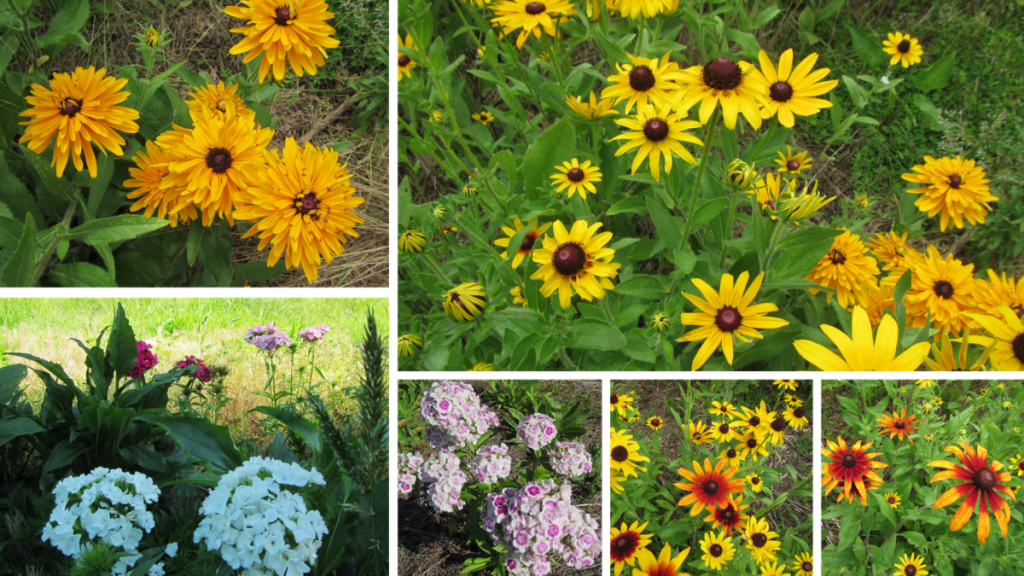Road construction and roads themselves can cause more problems than just a rush hour traffic jam. My research focuses on using wildflowers to help reduce some of these problems – in addition to being pretty!
Paved surfaces, such as roads, cannot absorb rain during storms. Rain or snowmelt becomes runoff that flows to the soils along roads. During road construction these soils are disturbed and may have a limited ability to soak up runoff. Runoff from roads typically contains harmful pollutants and contaminants. Streams, rivers, and lakes can be harmed by these contaminants if the runoff is not infiltrated by soils on the roadside first. In regions that receive a lot of precipitation year-round, this can be a big problem.
Turf grass is typically planted in the soils along roadsides after construction. It provides an inexpensive, low-tech way to minimize the runoff leaving roads. Crews may work to improve the soil with tillage or compost to improve how this system absorbs runoff. However, managing the grass by mowing can compact soils which limits their ability to absorb water. This is especially true in southern areas with longer growing seasons.

Compared to grass, wildflowers have the potential to remove more water through evapotranspiration. Wildflowers require less intensive maintenance and do not need frequent mowing. This may increase the benefits of soil improvement methods, such as tillage, and increase the ability of roadside soils to absorb runoff and filter pollutants long-term.
When working toward my Masters’ degree at North Carolina State University, I researched the use of alternative vegetation along roadsides. Our study compared the potential of tilled soils with planted with turf grass compared to tilled soil planted with wildflowers. We measured each system’s ability to infiltrate runoff from roads during rainstorms. We hoped to determine which system absorbed runoff better.
We established experimental plots next to highway roads to test the effects of different vegetation on the amount of runoff absorbed by the soils in each plot. We made plots with three types of soil treatments: existing grass (unaltered), tillage with grass, and tillage with wildflowers. We used wildflowers native to North Carolina, like coneflower and Black-Eyed Susan.

Water from rain, road runoff or snowmelt can move across the top of the soil – runoff – or into the soil – absorption. The hope is to find the best system to absorb water into the soil and not allow it to become runoff and keep it out of waterbodies.
After making our systems, we collected any runoff – the water that was not absorbed by the soil system. We collected the runoff water in a large tub. We also measured the bulk density (mass/volume) and the infiltration rates (amount of water absorbed per hour) in the soils of each plot at the end of the experiment. These are measures of how soil functions and how healthy it is.
It makes sense that the amount of runoff increased with the amount of rainfall in all plots; more rain means more runoff.

After we tilled and planted with turf or wildflower seeds, runoff was lower in both turf grass and wildflower plots compared to the unaltered control plots. However, turf grass and wildflowers absorbed the same amount of runoff – neither was better than the other. There also wasn’t a difference in soil health or soil function.
So, just looking at the impact of a turf grass system or wildflower system on reducing runoff, they are the same. But there is a difference when one looks at the broader functions of turf grass and wildflower systems.
Wildflowers provide many co-benefits that are not provided by grasses. Wildflowers increase pollinator habitat and biodiversity. Wildflowers have deeper roots that can stabilize soils and reduce erosion. The need for mowing is decreased with wildflowers, reducing the compaction from the tires of mowers. Reducing the activities that cause compaction, like frequent mowing with heavy equipment, is essential to maintaining the soil improvements of tillage and vegetation growth through time.

Wildflowers provide a great alternative to grasses for roadside vegetation. When paired with tillage, they can improve soil conditions, increase infiltration rates, decrease runoff from paved roads. Wildflowers not only are beautiful but provide food and homes for pollinators and other wildlife, improving the aesthetics and health of roadsides.
Answered by Erin Rivers, Utah State University
To receive notices about future blogs, be sure to subscribe to Soils Matter by clicking on the Follow button on the upper right! Explore more on our webpage About Soils. There you will find more information about Soil Basics, Community Gardens, Green Infrastructure, Green Roofs, Soil Contaminants, materials for Teachers and more.

flower power!